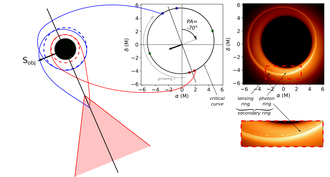
In a preprint recently posted on arxiv, an international team of scientists from France, USA and Poland, led by Frederic Vincent from Paris Observatory, discusses the images of M87*, the supermassive compact object at the center of the Messier 87 (M87) galaxy, published last year by the Event Horizon Telescope Collaboration (EHT). The authors attempt to answer the question, to what extent the EHT observations could be explained by an exotic compact object rather than a classic general relativistic black hole characterized by the Kerr metric. The alternatives considered in the paper include a flat spacetime Michell-Laplace black hole, an ultracompact star (such as a gravastar), a boson star, and a wormhole.
In the paper, the properties of photons’ trajectories in different spacetimes are investigated. By studying geometric models of a radiating accretion disk around the central mass and ray-tracing the emission pattern in non-Kerr spacetimes, the simulated images of exotic objects are obtained. They can be compared with the EHT results. The authors discuss the relative importance of the compact object gravity field, as opposed to the astrophysical assumptions on the accretion flow. They show that simply by manipulating the emission geometry model and adjusting the mass and alignment of the object, images consistent with the EHT results can be produced for each of the considered exotic spacetimes. This situation is partly related to the angular resolution limitations of the current observations. Hence, strong tests of the Einstein’s theory of general relativity seem to be out of reach with the M87 data released so far. However, the authors notice that the anticipated future developments of the EHT capabilities may allow to probe the regime of the extremely high spatial frequencies, and uncover more fundamental spacetime signatures such as the presence of a secondary ring, indicating the existence of unstable spherical photon orbits. Such orbits exist in the Kerr spacetime, but are absent for numerous alternative objects.
Among the authors of the publication, Marek Abramowicz and Jean-Pierre Lasota represent the Nicolaus Copernicus Astronomical Center in Warsaw. The leading authors, Frederic Vincent and Maciek Wielgus, both are former CAMK postdoctoral researchers.
Picture:
The formation of a secondary ring in a Kerr black hole image. Credit: F. Vincent
Links:
"Geometric modeling of M87* as a Kerr black hole or a non-Kerr compact object"
Text: Maciej Wielgus






